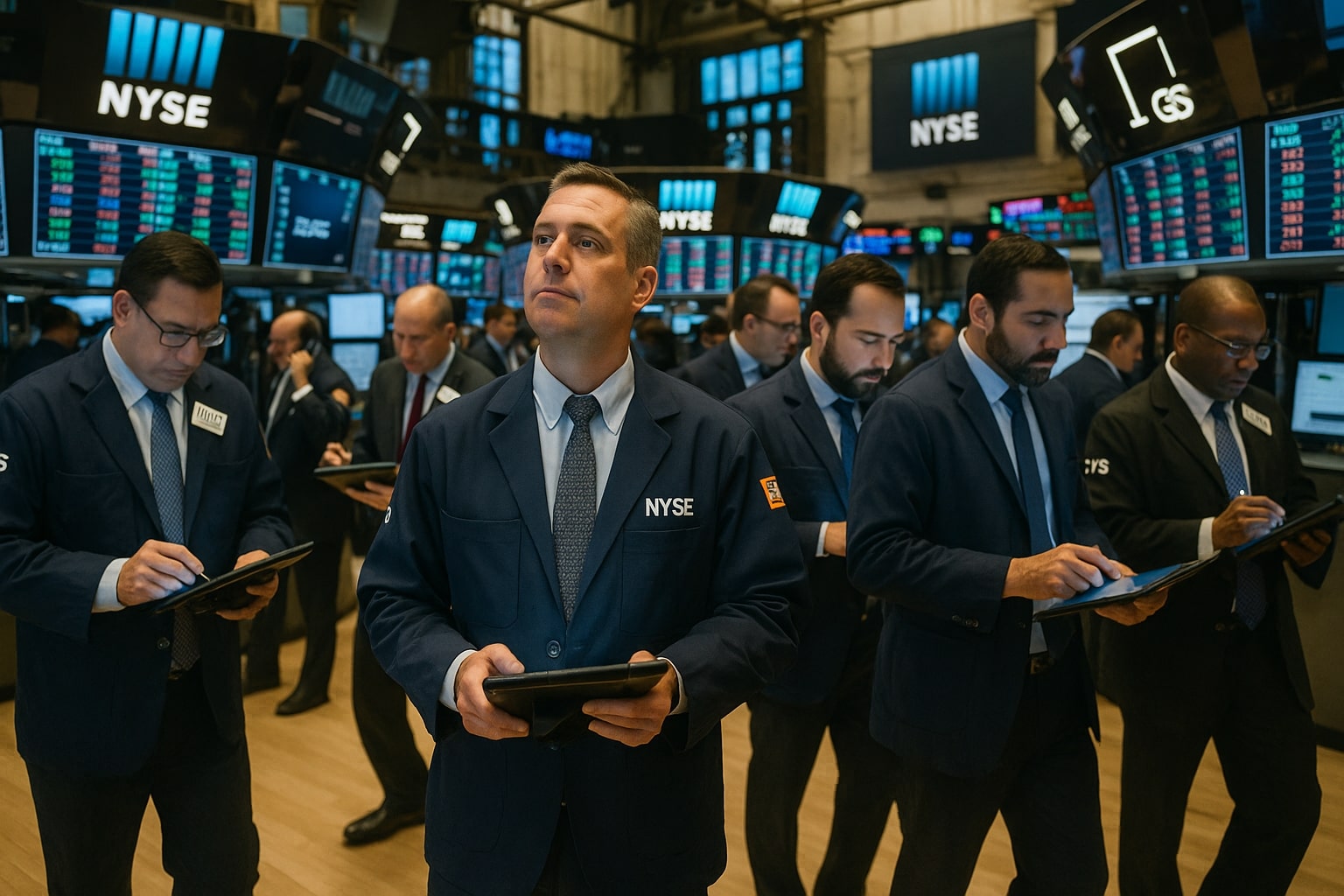
Meta Stock Price Forecast - Meta Faces $16B Tax Blow and $100B CapEx Shock as Shares Sink to $587
After a sharp 12% post-earnings crash, Meta (NASDAQ:META) faces investor backlash over record spending and executive exits, even as Q3 sales hit $51.24B (+26% YoY) and daily users reach 3.54B | That's TradingNEWS
NASDAQ:META Faces AI Transition Shock as $16B Tax Hit, Rising CapEx, and Executive Exits Test Investor Patience
Meta Platforms (NASDAQ:META) closed at $587.14, down 0.54%, after an extended selloff that wiped over $240 billion in market capitalization since late October. The decline followed a string of major developments — a $16 billion non-cash tax charge, escalating CapEx guidance to $72 billion, and the abrupt departure of Chief AI Scientist Yann LeCun, one of the key architects of Meta’s artificial intelligence ecosystem. These events come at a critical moment for Meta as it attempts to reposition itself in the global AI race amid slowing investor confidence and intensifying competitive pressure from Alphabet (NASDAQ:GOOGL), OpenAI, and Anthropic.
Revenue in Q3 2025 came in at $51.24 billion, up 26% year-over-year, marking Meta’s strongest top-line acceleration since early 2024. However, the company’s aggressive spending and accounting distortions cloud the underlying profitability picture. GAAP EPS collapsed 83% to $1.05, distorted by the Trump Administration’s “One Big Beautiful Bill Act”, which imposed a $15.93 billion one-time deferred tax charge. Adjusted for this, non-GAAP EPS stood at $7.25, up 20% YoY, reaffirming that operationally, Meta’s fundamentals remain intact.
CapEx Surge and the $100B 2026 Guidance Shock
Meta’s CapEx trajectory remains the central point of contention. The company’s Q3 spending reached $19.37 billion, more than double the prior year, with full-year projections between $70 billion and $72 billion. CEO Mark Zuckerberg’s remarks that 2026 CapEx would be “notably higher, potentially over $100 billion” triggered an investor exodus. The market reaction was severe — a 12% one-day crash in late October, the steepest since October 2022.
While investors perceive this as a spending excess, the structure of this CapEx indicates 70–75% growth investment rather than maintenance expenditure. Depreciation and amortization (D&A) stood at $4.96 billion, implying only ~25% of total CapEx relates to sustaining operations. The remainder is being poured into AI data centers, computing clusters, and next-generation infrastructure for Llama models and Meta AI integration across its ecosystem.
Free cash flow (FCF) remained robust at $10.62 billion, underscoring Meta’s ability to sustain heavy investment without endangering liquidity. However, investors’ discomfort stems from the timing mismatch between CapEx and monetization. Despite AI-driven ad performance improvements, these returns are expected to compound gradually over 2026–2027 rather than immediately.
Leadership Rift: LeCun’s Exit and Strategic Redirection
The resignation of Yann LeCun, Meta’s chief AI scientist since 2013 and Turing Award winner, has rattled internal and investor confidence. LeCun’s departure symbolizes a philosophical clash inside Meta’s AI division — between long-horizon foundational AI research (LeCun’s “world model” vision) and Zuckerberg’s short-cycle applied AI focus driven by monetizable outputs.
LeCun’s exit coincided with the appointment of Alexander Wang, a 28-year-old technologist tasked with leading Meta’s superintelligence initiative, signaling a generational shift in approach. The move followed the earlier departures of AI VP Joelle Pineau and CRO John Hegeman, marking a significant leadership vacuum in Meta’s AI strategy.
These transitions come as the Llama 4 model — Meta’s response to GPT-4 and Gemini — reportedly underperformed benchmarks in comprehension and latency. Internal restructuring aims to accelerate iteration cycles, but it also risks cultural friction and loss of Meta’s long-term AI innovation ethos.
Ad Business Resilience: User and Revenue Metrics Hit Record Highs
Despite the turbulence, Meta’s Family of Apps (FoA) division continues to deliver powerful financial results. Daily active users across Facebook, Instagram, WhatsApp, and Threads reached 3.54 billion, a 7.6% increase YoY, while Average Revenue Per Person (ARPP) rose to $14.46, up 17.7%. Ad impressions surged 14% globally, with cost per ad increasing 10%, reflecting stronger demand elasticity driven by AI-enhanced targeting.
Meta’s revenue growth of 26% YoY outpaced both Alphabet (+11%) and Snap (+9%), confirming continued ad market dominance. The momentum is strongest in Asia-Pacific and Europe, where AI-driven engagement optimization boosted click-through rates by 12–15%. The U.S. and Canada regions lagged slightly but still recorded sequential improvements.
Reality Labs: Persistent Drag on Profitability
Reality Labs remains Meta’s most problematic division. In Q3, the unit generated $470 million in revenue against a staggering $4.43 billion operating loss, bringing cumulative losses to over $50 billion since inception. Despite modest hardware updates in Quest 3, consumer adoption of virtual and mixed reality remains weak.
The firm’s ambition to merge Reality Labs with AI development pipelines in 2026 — particularly for spatial computing and neural rendering — suggests Zuckerberg still views the metaverse as integral to Meta’s long-term identity. Yet, the timeline for financial viability remains distant, and the segment continues to erode margins across the consolidated entity.
Accounting Distortions and Hidden Profitability
Meta’s official GAAP valuation metrics appear inflated due to accounting anomalies. The reported TTM P/E ratio of 25.97 and FWD P/E of 22.66 overstate Meta’s true multiple because the tax hit and CapEx acceleration distort net income visibility. Adjusting for one-time items and segregating growth CapEx from maintenance, Meta’s owner’s earnings (OE) are approximately 23% higher than GAAP-reported earnings, suggesting a more accurate implied P/E near 18.5x.
This implies Meta trades at a 17% discount to its 5-year average multiple of 25.4x, despite superior revenue velocity and margin expansion potential. The company’s market cap of $1.48 trillion represents only 6.5x forward sales, substantially lower than peers like NVIDIA (NASDAQ:NVDA) at 14x and Alphabet at 7.8x, highlighting valuation compression not reflective of fundamentals
Read More
-
Palantir Stock Price Forecast - PLTR Delivers Record Quarter With $1.18B Revenue Surge and Expanding Nvidia Partnership
20.11.2025 · TradingNEWS ArchiveStocks
-
XRP Price Forecast - XRP-USD Tests $2.00 as XRP ETF Boom Fails to Halt 11% Weekly Drop
20.11.2025 · TradingNEWS ArchiveCrypto
-
Oil Price Forecast - Oil Prices Recover as U.S. Draw Depletes 3.4M Barrels
20.11.2025 · TradingNEWS ArchiveCommodities
-
Stock Market Today: NVDA +5%, WMT +6%, TSLA +5% Drive Nasdaq to 23,045 in Explosive AI-Led Rally
20.11.2025 · TradingNEWS ArchiveMarkets
-
GBP/USD Price Forecast - Pound Slides Toward 1.3050 as Hawkish Fed and Weak UK CPI
20.11.2025 · TradingNEWS ArchiveForex
Regulatory Relief: FTC Case Dismissal Reduces Legal Overhang
Meta secured a significant legal win when Judge James Boasberg dismissed the Federal Trade Commission’s antitrust case challenging its acquisitions of Instagram and WhatsApp. The ruling stated the FTC “failed to demonstrate current monopoly power,” effectively removing a multiyear risk factor from Meta’s valuation equation. The decision also indirectly validated the firm’s competitive positioning amid rising challenges from TikTok and AI-driven social platforms.
Expense Discipline and Profit Quality
Meta’s total expenses rose modestly to $116–118 billion guidance for FY2025, driven primarily by R&D, which expanded to 30% of revenue from 28% YoY. Marketing & Sales declined as a share of revenue, while General & Administrative expenses rose slightly to 7%, reflecting higher stock-based compensation post-layoffs. Cost of revenue remained stable at 18%, underscoring operational discipline despite scaling challenges.
Excluding one-time charges, Meta’s operating margin stands near 38%, among the highest in Big Tech, second only to Alphabet. Meta’s advertising margin resilience offsets the CapEx-heavy outlays, preserving free cash flow and enabling a dividend yield of 0.36% and consistent buybacks, which totaled $14 billion YTD.
Investor Sentiment and Market Reaction
Following Q3 results, Meta became the worst-performing “Magnificent 7” stock YTD, alongside Amazon (NASDAQ:AMZN), with shares down 19% over one month and 1% YTD. RSI readings near 25.5 indicate extreme oversold conditions — levels not seen since the April 2025 tariff panic. Institutional sentiment, however, remains bifurcated: Wall Street consensus remains “Strong Buy” (4.58/5), while quant models lean “Hold” (3.27/5), reflecting short-term uncertainty in earnings visibility.
Insider transactions show mixed activity (see insider transactions). Over the past quarter, senior executives have exercised $41 million worth of options, though no major open-market purchases have occurred, signaling cautious internal sentiment during the transition phase.
Strategic Outlook and Technical Positioning
Meta’s forward revenue guidance of $56–59 billion for Q4 implies ~18.8% YoY growth, suggesting a deceleration but still outperforming most of the communication services sector. Technically, META faces key support at $580, with resistance near $610, followed by $642. RSI oversold signals and MACD divergence point to a potential short-term recovery, but broader sentiment hinges on CapEx communication and AI performance clarity in Q1 2026.
Meta’s balance sheet remains formidable, with $58.6 billion in cash and $18 billion in long-term debt, providing flexibility for continued AI and infrastructure scaling. The challenge lies in bridging investor perception with operational reality — convincing markets that current CapEx is foundation-building, not reckless spending.
Verdict: NASDAQ:META — STRONG BUY
At $587, Meta Platforms (NASDAQ:META) trades at valuation levels that underprice its growth, balance sheet strength, and AI leverage. Despite leadership disruption and short-term volatility, the company’s ad ecosystem and AI integration momentum remain unmatched. The stock’s forward P/E compression to 22.6x, ARPP growth of 17.7%, and free cash flow resilience present a favorable risk/reward setup.
Meta’s structural advantages in ad personalization, multi-platform integration, and AI-driven monetization justify a Strong Buy stance, with a 12–18 month target range of $720–$750, representing ~25% upside once CapEx normalization and AI returns materialize.
Real-Time Chart: View NASDAQ:META live price



















